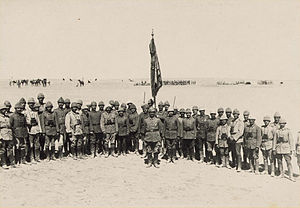First battle for Gaza
| date | March 26, 1917 |
|---|---|
| place | Gaza |
| output | Ottoman defensive victory |
| Parties to the conflict | |
|---|---|
| Commander | |
| Troop strength | |
| 3 infantry and 3 cavalry divisions with about 31,000 men | 1 infantry divisions and 7 regiments with about 19,000 men |
| losses | |
|
523 dead |
about 300 dead |
1915: Suez Canal
1917: Rafah - Gaza (1) - Gaza (2) - Beersheba - Gaza (3) - El Mughar - Jerusalem
1918: Jericho - Tell 'Asur - Jordan (1) - Jordan (2) - Abu Tellul - Megiddo
During the First Battle of Gaza , British , Australian and New Zealand troops tried unsuccessfully on March 26, 1917 to capture the strategically important city of Gaza . The battle was part of the Entente's Palestine campaign , in which their forces had conquered Sinai by early 1917.
background
During the First World War , the Entente and stood Ottoman Empire at Sinai and in Mesopotamia over. In January 1917, the Egyptian Expeditionary Force succeeded in concluding the conquest of Sinai with the Battle of Rafah . The war cabinet ordered defensive operations after the battle. However, the EEF prepared for another offensive by building a railway line through the Sinai towards Gaza and bringing in ammunition and supplies. In March 1917, Baghdad fell to the British. This and the entry of the USA into the war induced the war cabinet to continue the offensive on the Palestine front.
The British commander Archibald Murray had 12,000 cavalrymen from the Anzac Mounted Division , 11,000 infantry and another 8,000 infantry in reserve. The British positions had moved closer to Khan Younis around 20 kilometers south of Gaza with the construction of the railway line . The defenders of the Ottoman Army had 4,000 infantry in the city and 15,000 reserves in the hinterland of Gaza. Murray's war plan envisaged cavalry encircling the city from the north, east, and south-east. The infantry would then take the city in a general attack from the south.
course
The attack began on the morning of March 28, 1917. By mid-morning the New Zealand cavalry had completed the containment operation around the city. Meanwhile, the artillery of the Entente armed forces bombed the city of 40,000. The infantry managed to get into the city center. Towards evening the Ottoman defenders were close to giving up. However, for fear of reinforcements and even greater losses of his own troops, Murray gave the order to withdraw, which came as a surprise to the fighting troops on both sides.
consequences
The losses of the British exceeded the losses of the Ottoman forces. The Entente forces lost 3,967 men, three quarters of them in the infantry. The Ottoman army recorded 2,447 losses. After the battle, General Murray spread the opinion that the battle had been a victory and published false figures for the Ottomans of 6,000 to 7,000 casualties to the press, which were also printed. His further failure in the Second Battle of Gaza in April 1917 resulted in his replacement by General Allenby . Gaza was captured by the Entente in the Third Battle of Gaza in November 1917.
Individual evidence
- ^ A b c d Eugene L. Rogan: The Fall of the Ottomans: The Great War in the Middle East 1914–1920. London 2016, pp. 327–333.
- ^ Damien Fenton: First Battle of Gaza. In Spencer C. Tucker: The Encyclopedia of World War I: A Political, Social and Military History. Santa Barbara 2005, Volume 1, p. 468.
- ^ Eugene L. Rogan: The Fall of the Ottomans: The Great War in the Middle East 1914-1920. London 2016, pp. 330–333, p. 344.


